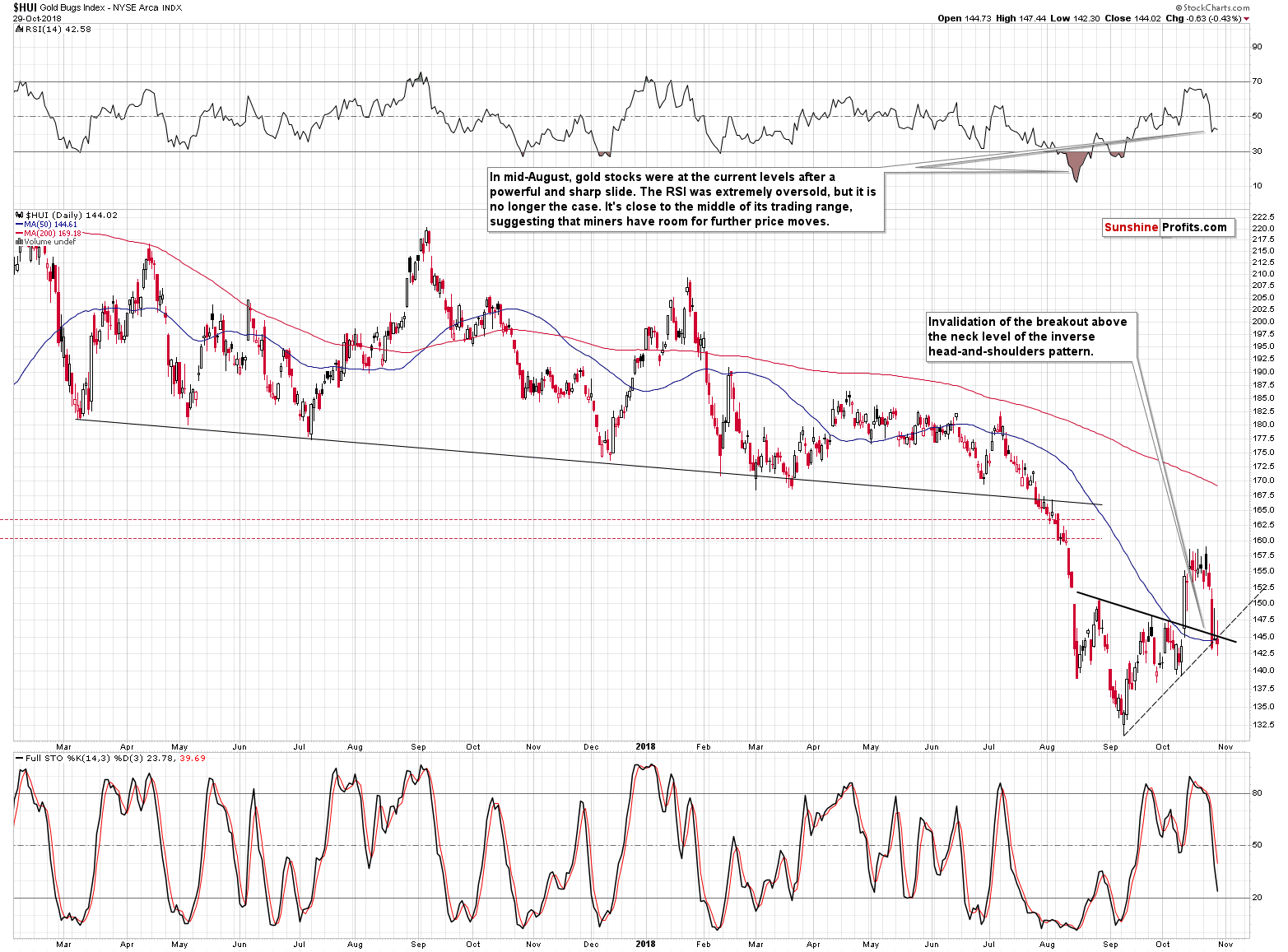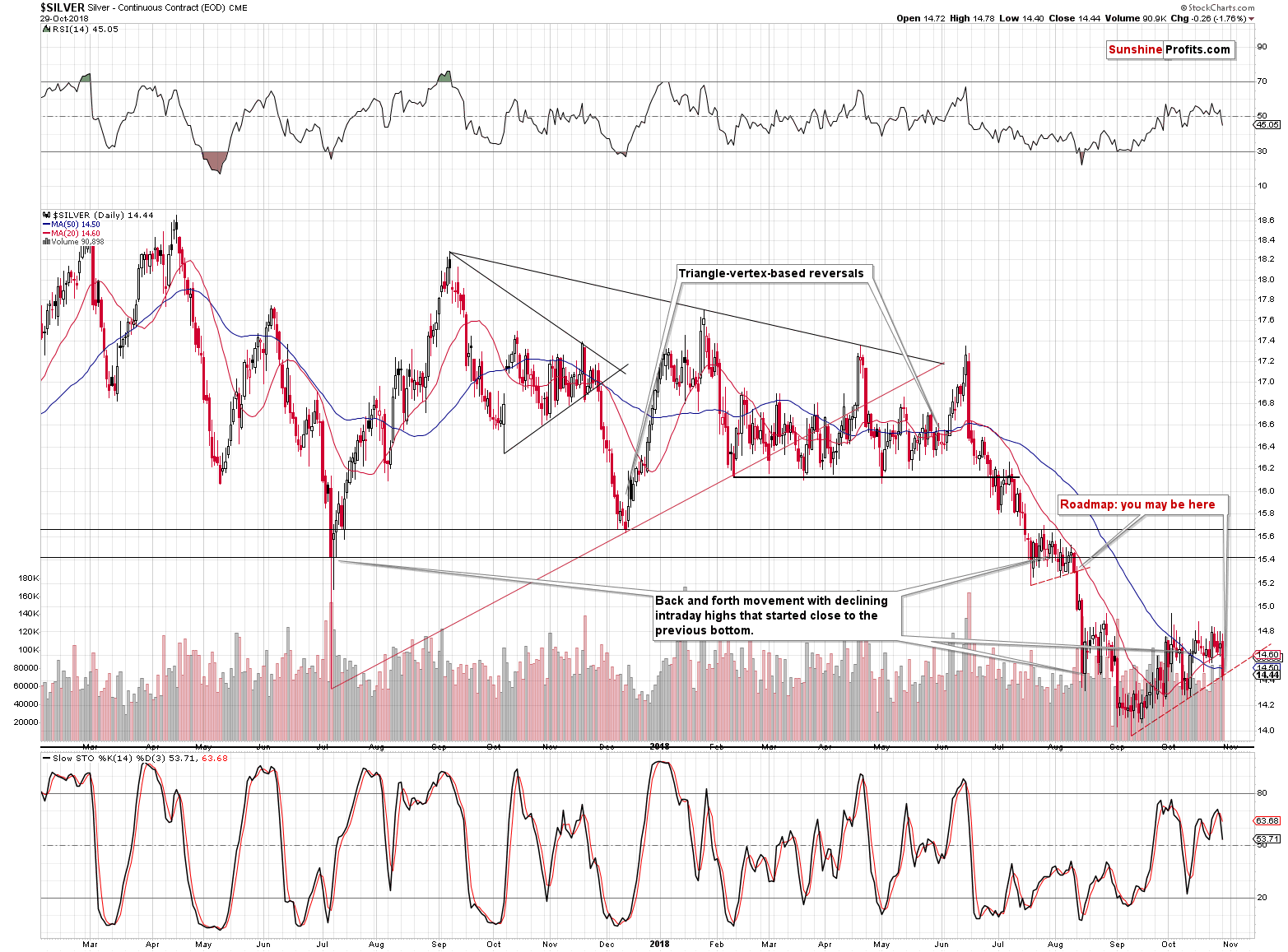Briefly: in our opinion, full (250% of the regular size of the position) speculative short positions in gold, silver and mining stocks are justified from the risk/reward perspective at the moment of publishing this alert.
Today’s Alert is going a follow-up yesterday’s extensive analysis, so if you haven’t had the chance to read it so far, we encourage you to do so now.
Gold, silver and mining stocks moved lower yesterday despite an attempt of the latter to rally above the neck level of the inverse head-and-shoulders pattern. That was another trading day in a row when miners tried to do it and failed. This is a clear sign that there is not enough strength to push miners’ prices higher and this doesn’t bode well for the near future of the precious metals sector.
Let’s take a look at the charts for details.
The Resumed Decline
The HUI Index, proxy for gold stocks, declined only about 0.5%, but this is significant nonetheless, because it was a close below the neck level of the inverse H&S. That was also a close below the rising short-term support line and thus a short-term breakdown. The implications are strongly bearish as miners appear to have completed a pause within a bigger downtrend, which is now ready to resume.
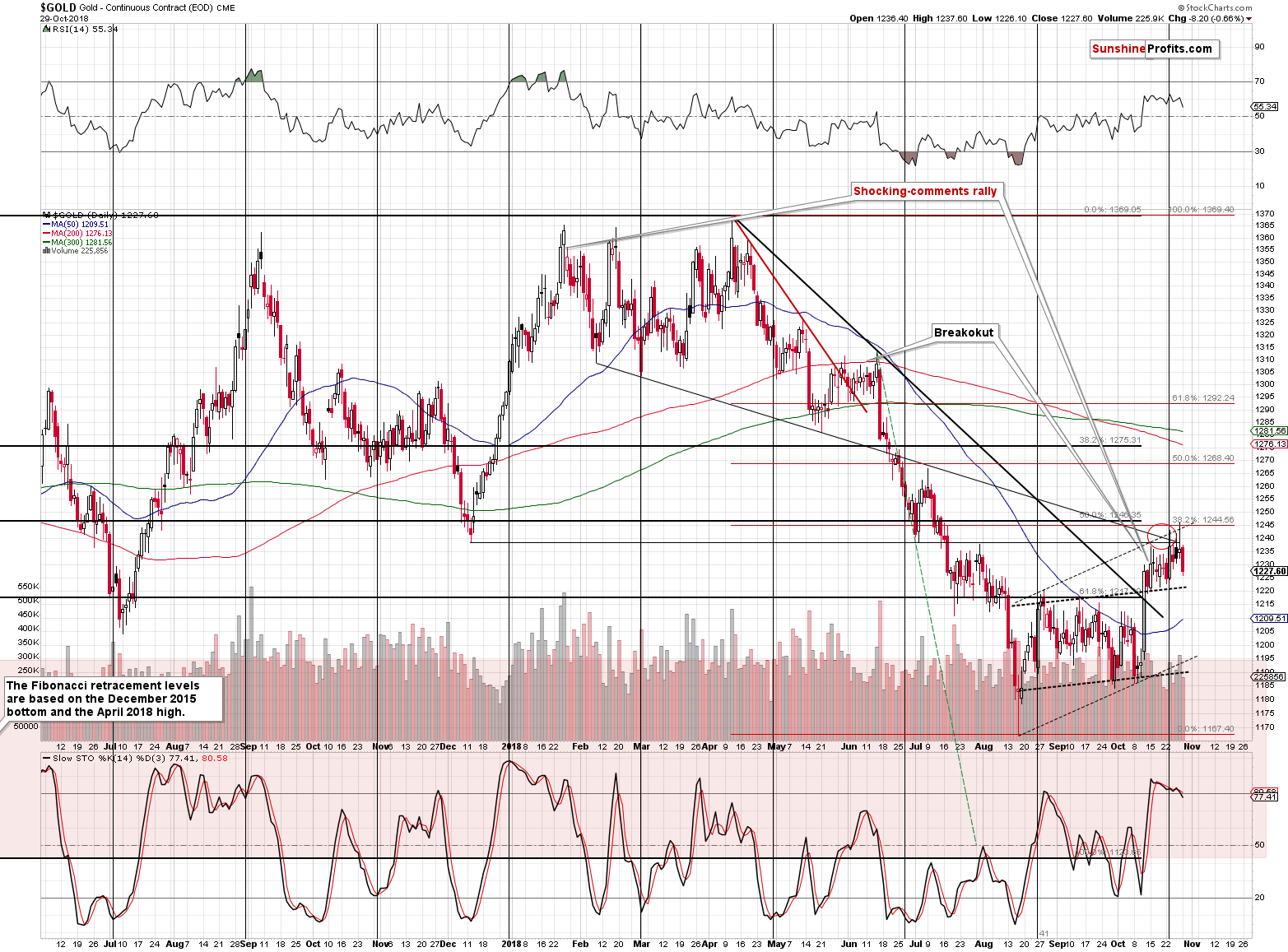
Gold declined after a clear shooting star pattern and while the move is still small relative to the entire October rally, but given miners’ lead, it seems that it will not take long before gold is down significantly as well.
Silver Short-term Analogy
Silver is leading gold in the decline as well, but it’s a normal course of action given the situation in the gold to silver ratio.
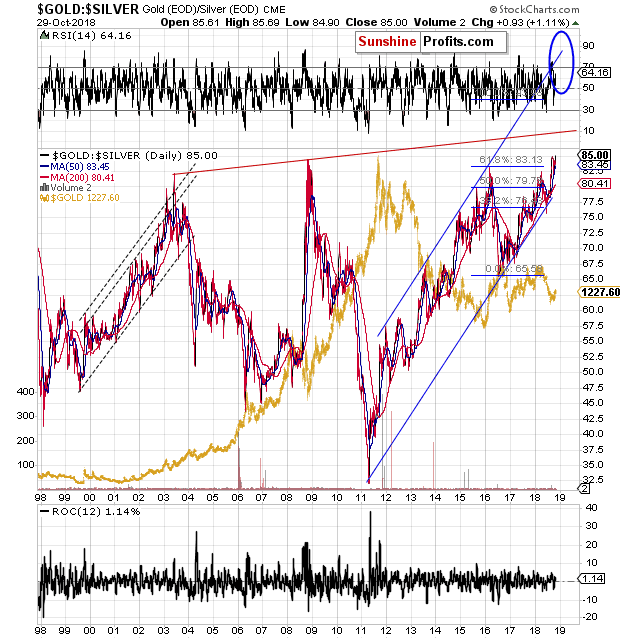
The ratio moved above the recent highs and it’s most likely on its way to its true long-term highs at about 100. The above chart is not long-term enough to feature those highs, but the one below is.
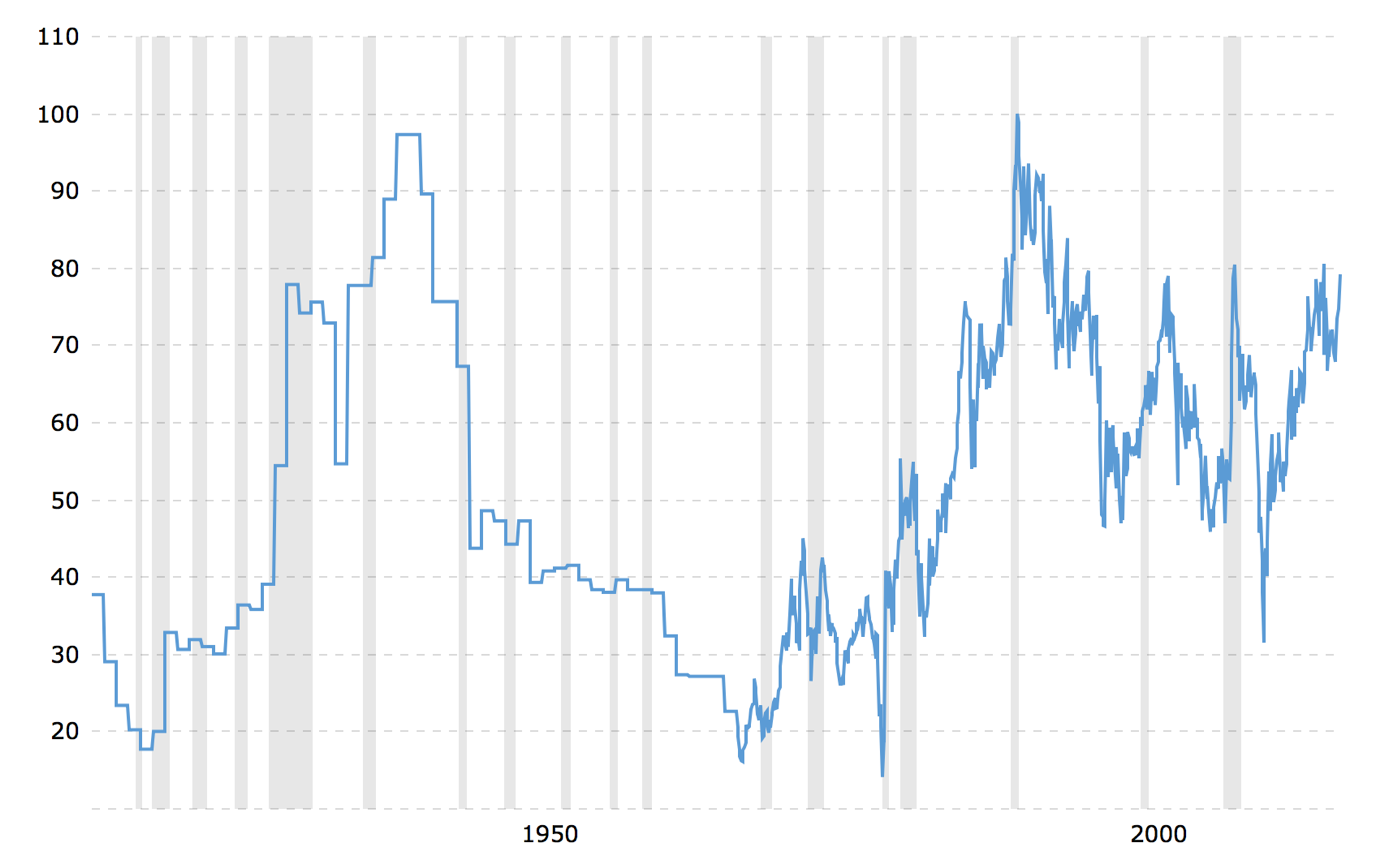
The real long-term target is at about 100 – this level stopped the huge rallies in the ratio in two key cases in the past, which makes it a natural target for the current rally (note: the above chart is not based on the most recent prices – in reality the ratio is already above the 2003 and 2008 highs).
The 100 target is also very important from the psychological point of view. The round numbers tend to work very well as support and resistance levels simply because a lot of people tend to notice them. “Silver now 100x as expensive as gold” would be an appealing headline, while “Silver now at 87.42x as expensive as gold” is not.
But, moving back to silver’s short-term chart, we would like to quote what we wrote about it yesterday:
Silver has been moving back and forth recently with lower intraday highs. This seems like nothing special, until you notice that almost exactly the same thing happened in late July and early August. Right before the sharp $1+ decline.
And it’s not only the shape that’s alike. We can see similarity also in terms of the price level around which both consolidations took place. It was a major bottom in terms of the daily closing prices. In July and August silver moved back and forth around the July 2017 bottom. In this case, silver is moving around the mid-August bottom.
Moreover, this time, silver is consolidating after breaking below a very important long-term support line.
If the similarity to the July – August is to continue (and that’s likely), then we may have just seen the pre-slide move. Please compare where silver closed yesterday and where it closed on August 10th. In both cases that was a move to the rising support line that was based on the previous short-term lows. If the analogy is to continue, silver is likely to decline significantly shortly – perhaps even today.
Important Analyses
Before summarizing, we would like to emphasize that we have recently posted several analyses that are very important and that one should keep in mind, especially in the next several weeks. If you haven’t had the chance of reading them previously, we encourage you to do so today:
- Dear Gold Investor - Letters from 2013 - Analogy to 2013, which should make it easier to trade the upcoming sizable upswing (if enough factors point to it, that is) and to enter the market close to the final bottom.
- Gold to Soar Above $6,000 - discussion of gold’s long-term upside target of $6,000.
- Preparing for THE Bottom in Gold: Part 6 – What to Buy - extremely important analysis of the portfolio structure for the next huge, multi-year rally in the precious metals.
- Preparing for THE Bottom in Gold: Part 7 – Buy-and-hold on Steroids - description of a strategy dedicated to significantly boosting one’s long-term investment returns while staying invested in the PM sector.
- Gold’s Downside Target, Upcoming Rebound, and Miners’ Buy Plan - details regarding the shape of the following price moves, a buying plan for mining stocks, and a brief discussion of the final price targets for the current decline.
- Gold: What Happened vs. What Changed - discussion of the latest extreme readings from gold’s CoT report
- Key Factors for Gold & Silver Investors - discussion of key, long-term factors that support the bearish outlook for PMs. We are often asked what makes us so bearish – this article is a reply to this question.
- The Upcoming Silver Surprise - two sets of price targets for gold, silver and mining stocks: the initial and the final one.
- Precious Metals Sector: It’s 2013 All Over Again - comparison between 2013 and 2018 throughout the precious metals sector, the general stock market and the USD Index. Multiple similarities point to the repeat of a 2013-style volatile decline in the PMs.
- Changing One's Mind - Why, When, and How – discussing the way of analyzing the market that helps to stay focused on the growing one’s capital while not being influenced by the loss aversion bias. This essay might be particularly useful in light of the recent upswing in the PMs.
- Inverse H&S Patterns and Something Even More Extreme - gold targets for the current decline in terms of price and time.
Summary
Summing up,there are multiple factors in place that point to much lower precious metals and mining stock prices in the coming days and weeks and the enormously bearish analogy to 2013 remains in place. All in all, it seems that the profits on our short positions will increase significantly very soon.
As always, we’ll keep you – our subscribers – informed.
To summarize:
Trading capital (supplementary part of the portfolio; our opinion): Full short positions (250% of the full position) in gold, silver and mining stocks are justified from the risk/reward perspective with the following stop-loss orders and exit profit-take price levels:
- Gold: profit-take exit price: $1,062; stop-loss: $1,257; initial target price for the DGLD ETN: $82.96; stop-loss for the DGLD ETN $49.27
- Silver: profit-take exit price: $12.72; stop-loss: $15.26; initial target price for the DSLV ETN: $46.97; stop-loss for the DSLV ETN $28.87
- Mining stocks (price levels for the GDX ETF): profit-take exit price: $13.12; stop-loss: $20.83; initial target price for the DUST ETF: $80.97; stop-loss for the DUST ETF $27.67
Note: the above is a specific preparation for a possible sudden price drop, it does not reflect the most likely outcome. You will find a more detailed explanation in our August 1 Alert. In case one wants to bet on junior mining stocks’ prices (we do not suggest doing so – we think senior mining stocks are more predictable in the case of short-term trades – if one wants to do it anyway, we provide the details), here are the stop-loss details and target prices:
- GDXJ ETF: profit-take exit price: $17.52; stop-loss: $31.23
- JDST ETF: initial target price: $154.97 stop-loss: $51.78
Long-term capital (core part of the portfolio; our opinion): No positions (in other words: cash)
Insurance capital (core part of the portfolio; our opinion): Full position
Important Details for New Subscribers
Whether you already subscribed or not, we encourage you to find out how to make the most of our alerts and read our replies to the most common alert-and-gold-trading-related-questions.
Please note that the in the trading section we describe the situation for the day that the alert is posted. In other words, it we are writing about a speculative position, it means that it is up-to-date on the day it was posted. We are also featuring the initial target prices, so that you can decide whether keeping a position on a given day is something that is in tune with your approach (some moves are too small for medium-term traders and some might appear too big for day-traders).
Plus, you might want to read why our stop-loss orders are usually relatively far from the current price.
Please note that a full position doesn’t mean using all of the capital for a given trade. You will find details on our thoughts on gold portfolio structuring in the Key Insights section on our website.
As a reminder – “initial target price” means exactly that – an “initial” one, it’s not a price level at which we suggest closing positions. If this becomes the case (like it did in the previous trade) we will refer to these levels as levels of exit orders (exactly as we’ve done previously). Stop-loss levels, however, are naturally not “initial”, but something that, in our opinion, might be entered as an order.
Since it is impossible to synchronize target prices and stop-loss levels for all the ETFs and ETNs with the main markets that we provide these levels for (gold, silver and mining stocks – the GDX ETF), the stop-loss levels and target prices for other ETNs and ETF (among other: UGLD, DGLD, USLV, DSLV, NUGT, DUST, JNUG, JDST) are provided as supplementary, and not as “final”. This means that if a stop-loss or a target level is reached for any of the “additional instruments” (DGLD for instance), but not for the “main instrument” (gold in this case), we will view positions in both gold and DGLD as still open and the stop-loss for DGLD would have to be moved lower. On the other hand, if gold moves to a stop-loss level but DGLD doesn’t, then we will view both positions (in gold and DGLD) as closed. In other words, since it’s not possible to be 100% certain that each related instrument moves to a given level when the underlying instrument does, we can’t provide levels that would be binding. The levels that we do provide are our best estimate of the levels that will correspond to the levels in the underlying assets, but it will be the underlying assets that one will need to focus on regarding the signs pointing to closing a given position or keeping it open. We might adjust the levels in the “additional instruments” without adjusting the levels in the “main instruments”, which will simply mean that we have improved our estimation of these levels, not that we changed our outlook on the markets. We are already working on a tool that would update these levels on a daily basis for the most popular ETFs, ETNs and individual mining stocks.
Our preferred ways to invest in and to trade gold along with the reasoning can be found in the how to buy gold section. Additionally, our preferred ETFs and ETNs can be found in our Gold & Silver ETF Ranking.
As a reminder, Gold & Silver Trading Alerts are posted before or on each trading day (we usually post them before the opening bell, but we don't promise doing that each day). If there's anything urgent, we will send you an additional small alert before posting the main one.
=====
Latest Free Trading Alerts:
On Thursday, Mr. Draghi held a press conference. But the real thunderbolt hit on Monday, when Ms. Merkel announced that she would step down this year as a leader of her conservative party. Will that lighting make gold shine?
Iron Lady of Europe Quits. Will Gold Replace Her?
=====
Thank you.
Sincerely,
Przemyslaw Radomski, CFA
Founder, Editor-in-chief, Gold & Silver Fund Manager
Gold & Silver Trading Alerts
Forex Trading Alerts
Oil Investment Updates
Oil Trading Alerts


